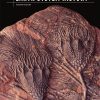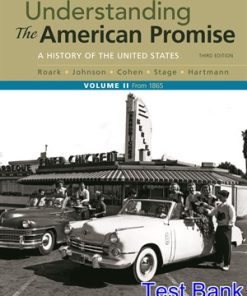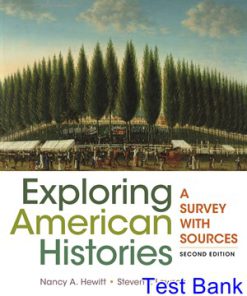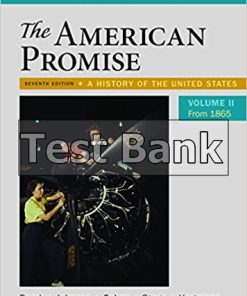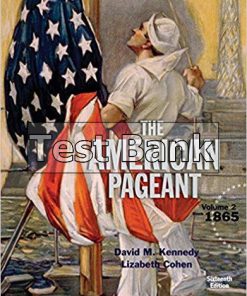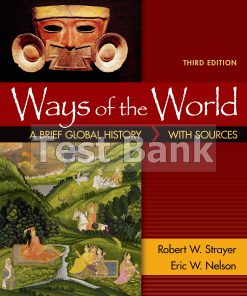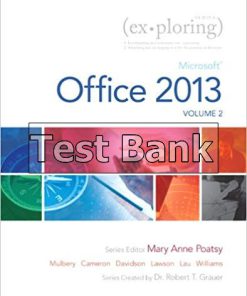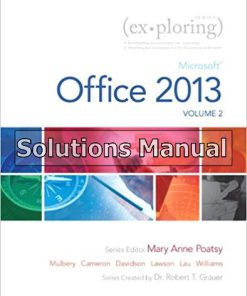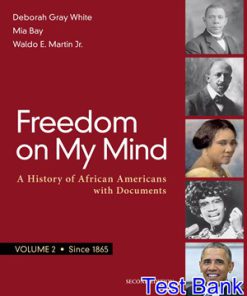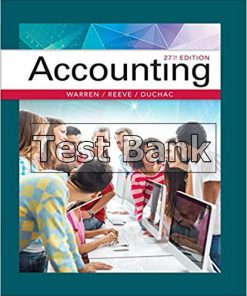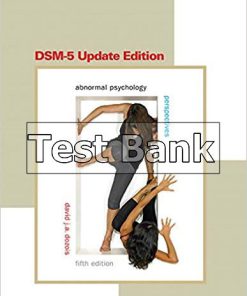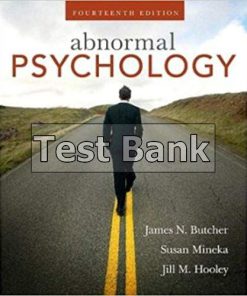Exploring American Histories Volume 2 A Survey with Sources 2nd Edition Hewitt Test Bank
$50.00 Original price was: $50.00.$26.50Current price is: $26.50.
Exploring American Histories Volume 2 A Survey with Sources 2nd Edition Hewitt Test Bank.
This is completed downloadable of Exploring American Histories Volume 2 A Survey with Sources 2nd Edition Hewitt Test Bank
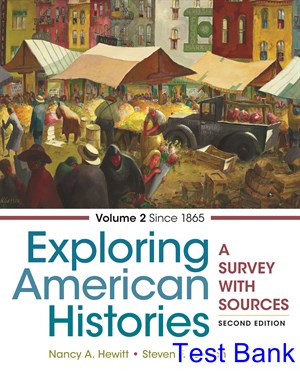
Product Details:
- ISBN-10 : 1457694719
- ISBN-13 : 978-1457694714
- Author: Nancy A. Hewitt (Author), Steven F. Lawson (Author)
Utilizing both written and visual primary sources, Exploring American Histories, Volume 2 breathes life into the many histories of this nation while helping you think crtically about the sources which lay the groundwork for historical narratives.
Table of Content:
Product Details
| ISBN-13: | 2901457694713 |
|---|---|
| Publisher: | Bedford/St. Martin’s |
| Publication date: | 09/07/2016 |
| Edition description: | Second Edition |
| Pages: | 680 |
| Product dimensions: | 6.00(w) x 1.25(h) x 9.00(d) |
Table of Contents
The Combined Volume includes all chapters.
Volume 1 includes Chapters 1-14.
Volume 2 includes Chapters 14-29.
[[*Indicates new to this edition]]NOTE: LaunchPad material that does not appear in the print book – including guided reading exercises, source feature quizzes, LearningCurve adaptive quizzes, summative quizzes, all of the documents from the companion reader Thinking through Sources for Exploring American Histories, and the activities built for projects in the reader – has been labeled on this table of contents as shown. Each chapter in the LaunchPad also comes with a wealth of additional documents, videos, key terms flashcards, map quizzes, timeline activities, and much more, all of which can be easily integrated and assigned.
CONTENTS
Guide to Analyzing Primary Sources
Preface
Versions and Supplements
Maps, Figures, and Tables
How to Use This Book
1 Mapping Global Frontiers
to 1590
Guided Reading Exercise LaunchPad
COMPARING AMERICAN HISTORIES
Malintzin and Martin Waldseemüller
Native Peoples in the Americas
Native Peoples Develop Diverse Cultures
The Aztecs, the Maya, and the Incas
Native Cultures to the North
Europe Expands Its Reach
The Mediterranean World
Portugal Pursues Long-Distance Trade
European Encounters with West Africa
GUIDED ANALYSIS
Source 1.1 Martin Waldseemüller and Mathias Ringmann, Universalis Cosmographia, 1507
Quiz for Guided Analysis LaunchPad
Worlds Collide
Europeans Cross the Atlantic
COMPARATIVE ANALYSIS
Who Are These Native People?
Source 1.2 Christopher Columbus, Description of His First Encounter with Indians, 1492 | Source 1.3 Antonio Pigafetta Journal, 1521
Quiz for Comparative Analysis LaunchPad
Europeans Explore the Americas
Mapmaking and Printing
The Columbian Exchange
Europeans Make Claims to North America
Spaniards Conquer Indian Empires
Spanish Adventurers Head North
Europeans Compete in North America
Spain Seeks Dominion in Europe and the Americas
*SECONDARY SOURCE ANALYSIS
Indians in the New Spanish Empire
Source 1.4 Camilla Townsend, An Indian Woman Aids in the Conquest of Mexico, 2006 | Source 1.5 Jane E. Mangan, Indians Seek to Benefit from Spanish Conquest, 2005
Quiz for Secondary Source Analysis LaunchPad
Conclusion: A Transformed America
LearningCurve LaunchPad
Chapter Review
Summative Quiz LaunchPad
PRIMARY SOURCE PROJECT 1
Indian and Spanish Encounters in the Americas, 1519–1530
Source 1.6 Hernán Cortés, Letter to King Charles I, 1520 | Source 1.7 Aztec Priests Respond to the Spanish, 1524 | Source 1.8 Hernán Cortés and Malintzin Meet Montezuma at Tenochtitlán, 1519 | Source 1.9 Álvar Núñez Cabeza de Vaca, La Relación, c. 1528
Quizzes for Primary Source Project 1 LaunchPad
1. Primary Source Projects for Exploring American Histories, Primary Source Project 1: Mapping America LaunchPad
Source 1.1 Christopher and Bartolomeo Columbus, Map of Europe and North Africa, c. 1490
Quiz for Source 1.1 LaunchPad
Source 1.2 Piri Reis Map, 1513
Quiz for Source 1.2 LaunchPad
Source 1.3 Dauphin Map of Canada, c. 1543
Quiz for Source 1.3 LaunchPad
Source 1.4 Map of Cuauhtinchan, 1550
Quiz for Source 1.4 LaunchPad
Interpret the Evidence and Put It in Context
Draw Conclusions from the Evidence for Thinking through Sources 1 LaunchPad
Essay Questions for Thinking through Sources 1 LaunchPad
2 Colonization and Conflicts
1580–1680
Guided Reading Exercise LaunchPad
COMPARING AMERICAN HISTORIES
John Smith and Anne Hutchinson
Religious and Imperial Transformations
The Protestant Reformation
Spain’s Global Empire Declines
France Enters the Race for Empire
GUIDED ANALYSIS
Source 2.1 A French Nun Reports a Huron Woman’s View of the Jesuits, 1640
Quiz for Guided Analysis LaunchPad
The Dutch Expand into North America
The English Seek an Empire
The English Establish Jamestown
Tobacco Fuels Growth in Virginia
Expansion, Rebellion, and the Emergence of Slavery
COMPARATIVE ANALYSIS
Indentured Servants In the Chesapeake
Source 2.2 Sarah Tailer Charges Captain and Mrs. Thomas Bradnox with Abuse, 1659 | *Source 2.3 Report of a Committee of the Assembly Concerning the Freedom of Elizabeth Key, 1656
Quiz for Comparative Analysis LaunchPad
The English Compete for West Indies Possessions
Pilgrims and Puritans Settle New England
Pilgrims Arrive in Massachusetts
The Puritan Migration
The Puritan Worldview
*SECONDARY SOURCE ANALYSIS
Colonial Models of and for English Society
Source 2.4 Jack P. Greene, The Chesapeake as a Model of and for English Society , 1988 |Source 2.5 Alan Taylor, New England Puritans Develop Anglo-American Ideals, 2001
Quiz for Secondary Source Analysis LaunchPad
Dissenters Challenge Puritan Authority
Wars in Old and New England
Conclusion: European Empires in North America
LearningCurve LaunchPad
Chapter Review
Summative Quiz LaunchPad
PRIMARY SOURCE PROJECT 2
Metacom’s War
Source 2.6 William Nahaton, Petition to Free an Indian Slave, 1675 | Source 2.7 Benjamin Church, A Visit with Awashonks, Sachem of the Sakonnet,1716 | Source 2.8 John Easton, A Relation of the Indian War, | Source 2.9 Edward Randolph, Report on the War, 1676 | Source 2.10 Mary Rowlandson, Narrative of Captivity, 1682
Quizzes for Primary Source Project 2 LaunchPad
2. Primary Source Projects for Exploring American Histories, Primary Source Project 2: Comparing Virginia and Massachusetts Bay Colonies LaunchPad
Source 2.1 John Smith, The Commodities in Virginia, c. 1612
Quiz for Source 2.1 LaunchPad
Source 2.2 Powhatan’s Viewpoint, as reported by John Smith, 1608
Quiz for Source 2.2 LaunchPad
Source 2.3 Richard Frethorne, Letter Home from Virginia, 1623
Quiz for Source 2.3 LaunchPad
Source 2.4 John Winthrop, A Model of Christian Charity, 1630
Quiz for Source 2.4 LaunchPad
Source 2.5 Capt. John Underhill, Attack at Mystic Connecticut, 1638
Quiz for Source 2.5 LaunchPad
Interpret the Evidence and Put It in Context
Draw Conclusions from the Evidence for Thinking through Sources 2 LaunchPad
Essay Questions for Thinking through Sources 2 LaunchPad
3 Colonial America amid Global Change
1680–1754
Guided Reading Exercise LaunchPad
COMPARING AMERICAN HISTORIES
William Moraley Jr. and Eliza Lucas
Europeans Expand Their Claims
English Colonies Grow and Multiply
The Pueblo Revolt and Spain’s Fragile Empire
France Seeks Land and Control
European Wars and American Consequences
Colonial Conflicts and Indian Alliances
Indians Resist European Encroachment
GUIDED ANALYSIS
Source 3.1 The Tuscarora Appeal to the Pennsylvania Government, 1710
Quiz for Guided Analysis LaunchPad
Conflicts on the Southern Frontier
The Benefits and Costs of Empire
Colonial Traders Join Global Networks
Imperial Policies Focus on Profits
The Atlantic Slave Trade
Seaport Cities and Consumer Cultures
COMPARATIVE ANALYSIS
The Middle Passage
Source 3.2 Plan of a Slave Ship, 1794 | Source 3.3 The Interesting Narrative of the Life of Olaudah Equiano, 1789
Quiz for Comparative Analysis LaunchPad
Labor in North America
Finding Work in the Colonies
Coping with Economic Distress
Rural Americans Face Changing Conditions
*SECONDARY SOURCE ANALYSIS
Individualism and Community in Colonial North America
Source 3.4 James T. Lemon, Individualism Flourishes in Pennsvylvania , 1972 | Source 3.5 James A. Henretta, Ethnic and Religious Bonds Foster Community, 1978
Quiz for Secondary Source Analysis LaunchPad
Slavery Takes Hold in the South
Africans Resist Their Enslavement
Conclusion: Changing Fortunes in British North America
LearningCurve LaunchPad
Chapter Review
Summative Quiz LaunchPad
PRIMARY SOURCE PROJECT 3
Tobacco and Slaves
Source 3.6 Virginia Slave Laws, 1662 and 1667 | Source 3.7 Joseph Ball Instructs His Nephew on Managing Enslaved Workers, 1743 | Source 3.8 Enslaved Blacks Working on a Tobacco Plantation, c. 1750 | Source 3.9 Richard Corbin Describes How to Become a Successful Planter, 1759 | Source 3.10 Lieutenant Governor William Gooch to the Board of Trade, London, 1729
Quizzes for Primary Source Project 3 LaunchPad
3. Primary Source Projects for Exploring American Histories, Primary Source Project 3: The Atlantic Slave Trade LaunchPad
Source 3.1 Venture Smith, A Narrative of the Life and Adventures of Venture, a Native of Africa, 1798
Quiz for Source 3.1 LaunchPad
Source 3.2 Thomas Phillips, Voyage of the Hannibal, 1694
Quiz for Source 3.2 LaunchPad
Source 3.3 Willem Bosman, A New and Accurate Description of the Coast of Guinea, 1703
Quiz for Source 3.3 LaunchPad
Source 3.4 Olaudah Equiano, The Interesting Narrative of the Life of Olaudah Equiano, 1789
Quiz for Source 3.4 LaunchPad
Source 3.5 Peter Blake, An Account of the Mortality of the Slaves Aboard the Ship James, 1675-1676
Quiz for Source 3.4 LaunchPad
Interpret the Evidence and Put It in Context
Draw Conclusions from the Evidence for Thinking through Sources 3 LaunchPad
Essay Questions for Thinking through Sources 3 LaunchPad
4 Religious Strife and Social Upheavals
1680–1754
Guided Reading Exercise LaunchPad
COMPARING AMERICAN HISTORIES
Gilbert Tennent and Sarah Grosvenor
An Ungodly Society?
The Rise of Religious Anxieties
Cries of Witchcraft
Family and Household Dynamics
Women’s Changing Status
GUIDED ANALYSIS
Source 4.1 Abigail Faulkner Appeals Her Conviction for Witchcraft, 1692
Quiz for Guided Analysis LaunchPad
Working Families
COMPARATIVE ANALYSIS
Elite Women’s Lives in the North American Colonies
Source 4.2 Isaac Royall and His Family, 1741 | Source 4.3 Eliza Lucas, Letter to Miss Bartlett, London, c. 1742
Quiz for Comparative Analysis LaunchPad
Reproduction and Women’s Roles
The Limits of Patriarchal Order
Diversity and Competition in Colonial Society
Population Growth and Economic Competition
Increasing Diversity
Expansion and Conflict
*SECONDARY SOURCE ANALYSIS
Finding a Middle Ground in New France
Source 4.4 Richard White, Cultural Accommodation on the Middle Ground, 1991 | Source 4.5 Brett Rushforth, Indian Slavery and Accommodation , 2014
Quiz for Secondary Source Analysis LaunchPad
Religious Awakenings
The Roots of the Great Awakening
An Outburst of Revivals
Religious Dissension
Political Awakenings
Changing Political Relations
Dissent and Protest
Transforming Urban Politics
Conclusion: A Divided Society
LearningCurve LaunchPad
Chapter Review
Summative Quiz LaunchPad
PRIMARY SOURCE PROJECT 4
Awakening Religious Tensions
Source 4.6 Nathan Cole, On George Whitefield Coming to Connecticut, 1740 | Source 4.7 Benjamin Franklin, On George Whitefield, the Great Revivalist, 1739 | Source 4.8 Jonathan Edwards, Sinners in the Hands of an Angry God, 1741 | Source 4.9 Newspaper Report on James Davenport, 1743 | Source 4.10 George Whitefield Preaching, c. 1760
Quizzes for Primary Source Project 4 LaunchPad
4. Primary Source Projects for Exploring American Histories, Primary Source Project 4: A New Commercial Culture in Boston LaunchPad
Source 4.1 Ship Arrivals and Departures at Boston, 1707
Quiz for Source 4.1 LaunchPad
Source 4.2 Goods for Sale, 1720
Quiz for Source 4.2 LaunchPad
Source 4.3 Advertisement for Musical Instruments, 1716
Quiz for Source 4.3 LaunchPad
Source 4.4 Chest of Drawers, c. 1735–1739
Quiz for Source 4.4 LaunchPad
Source 4.5 Advertisement for Runaway Slave, 1744
Quiz for Source 4.5 LaunchPad
Source 4.6 Letter from a Boston Protester, 1737
Quiz for Source 4.6 LaunchPad
Interpret the Evidence and Put It in Context
Draw Conclusions from the Evidence for Thinking through Sources 4 LaunchPad
Essay Questions for Thinking through Sources 4 LaunchPad
5 Wars and Empires
1754–1774
Guided Reading Exercise LaunchPad
COMPARING AMERICAN HISTORIES
George Washington and Hermon Husband
Imperial Conflicts and Indian Wars, 1754–1763
The Opening Battles
A Shift to Global War
The Costs of Victory
Battles and Boundaries on the Frontier
Conflicts over Land and Labor Escalate
GUIDED ANALYSIS
Source 5.1 Hermon Husband, Causes of Armed Resistance in North Carolina, 1770
Quiz for Guided Analysis LaunchPad
Postwar British Policies and Colonial Unity
Common Grievances
Forging Ties across the Colonies
Great Britain Seeks Greater Control
Resistance to Britain Intensifies
The Stamp Act Inspires Coordinated Resistance
The Townshend Act
The Boston Massacre
COMPARATIVE ANALYSIS
Protesting the Stamp Act
Source 5.2 London Merchants Petition to Repeal the Stamp Act, 1766 | Source 5.3 The Repeal, 1766
Quiz for Comparative Analysis LaunchPad
Continuing Conflicts at Home
Tea and Widening Resistance
The Continental Congress and Colonial Unity
*SECONDARY SOURCE ANALYSIS
Colonial Identities in Eighteenth Century British North America
Source 5.4 Gordon Wood, Britain’s Influence on Colonial Identities, 1993 | Source 5.5 John Butler, American Influences on Colonial Identities , 2000
Quiz for Secondary Source Analysis LaunchPad
Conclusion: Liberty within Empire
LearningCurve LaunchPad
Chapter Review
Summative Quiz LaunchPad
PRIMARY SOURCE PROJECT 5
The Boston Massacre
Source 5.6 Deposition of William Wyatt, March 7, 1770 | Source 5.7 Account of Boston Massacre Funeral Procession, March 12, 1770 | Source 5.8 Paul Revere, Etching of the Boston Massacre, 1770 | Source 5.9 Account of Captain Thomas Preston, June 25, 1770 | Source 5.10 John Adams, Defense of the British Soldiers at Trial, October 1770
Quizzes for Primary Source Project 5 LaunchPad
5. Primary Source Projects for Exploring American Histories, Primary Source Project 5: Defining Liberty, Defining America LaunchPad
Source 5.1 The Albany Plan of Union, 1754
Quiz for Source 5.1 LaunchPad
Source 5.2 Boycott Agreement of Women in Boston, 1770
Quiz for Source 5.2 LaunchPad
Source 5.3 Peter Bestes and Massachusetts Slaves, Letter to Local Representatives, 1773
Quiz for Source 5.3 LaunchPad
Source 5.4 Paul Revere, “The Able Doctor, or the American Swallowing the Bitter Draught,” 1774
Quiz for Source 5.4 LaunchPad
Source 5.5 J. Hector St. John de Crevecoeur, Letters from an American Farmer, 1782
Quiz for Source 5.5 LaunchPad
Interpret the Evidence and Put It in Context
Draw Conclusions from the Evidence for Thinking through Sources 5 LaunchPad
Essay Questions for Thinking through Sources 5 LaunchPad
6 The American Revolution
1775–1783
Guided Reading Exercise LaunchPad
COMPARING AMERICAN HISTORIES
Thomas Paine and Deborah Sampson
The Question of Independence
Armed Conflict Erupts
Building a Continental Army
Reasons for Caution and for Action
Declaring Independence
GUIDED ANALYSIS
Source 6.1 Thomas Paine, Common Sense, January 1776
Quiz for Guided Analysis LaunchPad
Choosing Sides
Recruiting Supporters
Choosing Neutrality
COMPARATIVE ANALYSIS
African Americans in New York City Amid the Upheavals of 1776
Source 6.2 Slaves Destroy Statue of King George III in New York City, 1776 | Source 6.3 A Fire Burns British-Occupied New York City, September 1776
Quiz for Comparative Analysis LaunchPad
Committing to Independence
*SECONDARY SOURCE ANALYSIS
Americans Decide to Revolt against British Rule
Source 6.4 Bernard Bailyn, The Importance of Ideas, 1967 | Source 6.5 Timothy H. Breen, Insurgents Mobilize, 2010
Quiz for Secondary Source Analysis LaunchPad
Fighting for Independence, 1776–1777
British Troops Gain Early Victories
Patriots Prevail in New Jersey
A Critical Year of Warfare
Patriots Gain Critical Assistance
Surviving on the Home Front
Governing in Revolutionary Times
Colonies Become States
Patriots Divide over Slavery
France Allies with the Patriots
Raising Armies and Funds
Indian Affairs and Land Claims
Winning the War and the Peace, 1778–1781
Fighting in the West
War Rages in the South
An Uncertain Peace
A Surprising Victory
Conclusion: Legacies of the Revolution
LearningCurve LaunchPad
Chapter Review
Summative Quiz LaunchPad
PRIMARY SOURCE PROJECT 6
Women in the Revolution
Source 6.6 Christian Barnes, Letter to Elizabeth Inman, April 29, 1775 | Source 6.7 Deborah Champion, Letter to Patience, October 2, 1775 | Source 6.8 Abigail Adams, Letter to John Adams, March 31, 1776 | Source 6.9 Esther De Berdt Reed, The Sentiments of an American Woman, 1780 | Source 6.10 Elizabeth “Mum Bett” Freeman, 1811
Quizzes for Primary Source Project 6 LaunchPad
6. Primary Source Projects for Exploring American Histories, Primary Source Project 6: Loyalists in the American Revolution LaunchPad
Source 6.1 Joseph Galloway, Speech to Continental Congress, 1774
Quiz for Source 6.1 LaunchPad
Source 6.2 Charles Inglis, The True Interest of America, Impartially Stated, 1776
Quiz for Source 6.2 LaunchPad
Source 6.3 Hannah Griffits, Response to Thomas Paine, 1777
Quiz for Source 6.3 LaunchPad
Source 6.4 Joseph Brant (Mohawk) Expresses Loyalty to the Crown (1776)
Quiz for Source 6.4 LaunchPad
Source 6.5 Boston King, Memoirs of the Life of Boston King, 1798
Quiz for Source 6.5 LaunchPad
Interpret the Evidence and Put It in Context
Draw Conclusions from the Evidence for Thinking through Sources 6 LaunchPad
Essay Questions for Thinking through Sources 6 LaunchPad
7 Forging a New Nation
1783–1800
Guided Reading Exercise LaunchPad
COMPARING AMERICAN HISTORIES
Daniel Shays and Alexander Hamilton
Financial, Frontier, and Foreign Problems
Continental Officers Threaten Confederation
Indians, Land, and the Northwest Ordinance
GUIDED ANALYSIS
Source 7.1 United Indian Nations Council, Message to Congress, 1786
Quiz for Guided Analysis LaunchPad
Depression and Debt
On the Political Margins
Separating Church and State
African Americans Struggle for Rights
Women Seek Wider Roles
COMPARATIVE ANALYSIS
Women and Free Blacks Claim Rights in the Nation
Source 7.2 Judith Sargent Murray, On the Equality of the Sexes, 1790 | Source 7.3 Petition from Free Blacks of Charleston, 1791
Quiz for Comparative Analysis LaunchPad
Indebted Farmers Fuel Political Crises
Reframing the American Government
The Constitutional Convention of 1787
Americans Battle over Ratification
Organizing the Federal Government
Hamilton Forges an Economic Agenda
Years of Crisis, 1792–1796
Foreign Trade and Foreign Wars
The Whiskey Rebellion
Further Conflicts on the Frontier
The First Party System
The Adams Presidency
The Election of 1800
*SECONDARY SOURCE ANALYSIS
The Election of 1800 Initiates Partisan Campaigning
Source 7.4 Eric Burns, Federalists Attack Thomas Jefferson, 2006 | Source 7.5
John Ferling, Democratic-Republicans Attack John Adams, 2013
Quiz for Secondary Source Analysis LaunchPad
Conclusion: A Young Nation Comes of Age
LearningCurve LaunchPad
Chapter Review
Summative Quiz LaunchPad
PRIMARY SOURCE PROJECT 7
Debating the Constitution in New York State
Source 7.6 James Madison, Federalist 10, The Union as a Safeguard Against Domestic Faction and Insurrection, November 1787 | Source 7.7 Melancton Smith, Antifederalist Argument at the New York State Convention, June 1788 | Source 7.9 Alexander Hamilton, Federalist Argument at the New York State Convention, June 1788 | Source 7.9 John Williams, Antifederalist Argument at the New York State Convention, June 1788 | Source 7.10 The Eleventh Pillar of the Great National Dome, 1788
Quizzes for Primary Source Project 7 LaunchPad
7. Primary Source Projects for Exploring American Histories, Primary Source Project 7: The Whiskey Rebellion LaunchPad
Source 7.1 Resolution to the Pennsylvania Legislature, 1791
Quiz for Source 7.1 LaunchPad
Source 7.2 “An Exciseman,” c. 1791
Quiz for Source 7.2 LaunchPad
Source 7.3 George Washington, Proclamation Against the Rebels, 1794
Quiz for Source 7.3 LaunchPad
Source 7.4 Alexander Hamilton, Letter to George Washington, August 5, 1794
Quiz for Source 7.4 LaunchPad
Source 7.5 James Madison, Letter to James Monroe, December 4, 1794
Quiz for Source 7.5 LaunchPad
Interpret the Evidence and Put It in Context
Draw Conclusions from the Evidence for Thinking through Sources 6 LaunchPad
Essay Questions for Thinking through Sources 6 LaunchPad
8 The Early Republic
1790–1820
Guided Reading Exercise LaunchPad
COMPARING AMERICAN HISTORIES
Parker Cleaveland and Sacagawea
The Dilemmas of National Identity
Education for a New Nation
Literary and Cultural Developments
*Religious Renewal
The Racial Limits of an American Culture
GUIDED ANALYSIS
Source 8.1 Samuel Jennings, Liberty Displaying the Arts and Sciences, 1792
Quiz for Guided Analysis LaunchPad
A New Capital for a New Nation
Extending Federal Power
A New Administration Faces Challenges
COMPARATIVE ANALYSIS
White Responses to Black Rebellion
Source 8.2 Thomas Jefferson, Letter to U.S. Minister to Great Britain Rufus King, July 1802 | Source 8.3 Leonora Sansay, Letter to Aaron Burr, November 1802
Quiz for Comparative Analysis LaunchPad
Acquiring the Louisiana Territory
The Supreme Court Extends Its Reach
*SECONDARY SOURCE ANALYSIS
Religion and Politics in the Early Republic
Source 8.4 Nathan O. Hatch, Religion as a Democratizing Force, 1989 |
Source 8.5 Amanda Porterfield, Religion Sows Doubt and Nurtures Partisanship, 2012
Quiz for Secondary Source Analysis LaunchPad
Democratic-Republicans Expand Federal Powers
Remaking America’s Economic Character
The U.S. Population Grows and Migrates
Technology Reshapes Agriculture and Industry
Transforming Household Production
Technology, Cotton, and Slaves
Conclusion: New Identities and New Challenges
LearningCurve LaunchPad
Chapter Review
Summative Quiz LaunchPad
PRIMARY SOURCE PROJECT 8
The Corps of Discovery: Paeans to Peace and Instruments of War
Source 8.6 William Clark, Journal, October 12, 1804 | Source 8.7 Charles McKenzie, Narrative of a Fur Trader, November 1804 | Source 8.8 William Clark, Journal, November 18, 1804 | Source 8.9 William Clark, Journal, January 28, 1805, and Meriwether Lewis, February 1, 1805 | Source 8.10 Meriwether Lewis, Journal, August 20, 1805
Quizzes for Primary Source Project 8 LaunchPad
8. Primary Source Projects for Exploring American Histories, Primary Source Project 8: Race Relations in the Early Republic LaunchPad
Source 8.1 Andrew Jackson, Runaway Slave Advertisement, 1804
Quiz for Source 8.1 LaunchPad
Source 8.2 Robert Sutcliff, Travels in Some Parts of North America, 1812
Quiz for Source 8.2 LaunchPad
Source 8.3 Richard Allen, Excerpt from The Life, Experience, and Gospel Labours of the Rt. Rev. Richard Allen, 1833
Quiz for Source 8.3 LaunchPad
Source 8.4 Free Blacks in Philadelphia Oppose Colonization, 1817
Quiz for Source 8.4 LaunchPad
Interpret the Evidence and Put It in Context
Draw Conclusions from the Evidence for Thinking through Sources 8 LaunchPad
Essay Questions for Thinking through Sources 8 LaunchPad
9 Defending and Redefining the Nation
1809–1832
Guided Reading Exercise LaunchPad
COMPARING AMERICAN HISTORIES
Dolley Madison and John Ross
Conflicts at Home and Abroad
Tensions at Sea and on the Frontier
War Erupts with Britain
GUIDED ANALYSIS
Source 9.1 Tecumseh, Speech to William Henry Harrison, 1810
Quiz for Guided Analysis LaunchPad
National Expansion and Regional Economies
Governments Fuel Economic Growth
Americans Expand the Nation’s Borders
Regional Economic Development
Economic and Political Crises
The Panic of 1819
Slavery in Missouri
The Expansion and Limits of American Democracy
Expanding Voting Rights
COMPARATIVE ANALYSIS
Protesting the Missouri Compromise
Source 9.2 Timothy Claimright, Maine Not to be Coupled with the Missouri Question, 1820 | Source 9.3 Thomas Jefferson, Letter to John Holmes, 1820
Quiz for Comparative Analysis LaunchPad
Racial Restrictions and Antiblack Violence
Political Realignments
The Presidential Election of 1828
Jacksonian Politics in Action
A Democratic Spirit?
*SECONDARY SOURCE ANALYSIS
Expanding American Democracy for Whom?
Source 9.4 Alexander Keyssar, Broadening the Franchise, 2000
| Source 9.5 James Oliver Horton and Lois E. Horton, The Limits of Democratic Expansion, 1997
Quiz for Secondary Source Analysis LaunchPad
Confrontations over Tariffs and the Bank
Contesting Indian Removal
Conclusion: The Nation Faces New Challenges
LearningCurve LaunchPad
Chapter Review
Summative Quiz LaunchPad
PRIMARY SOURCE PROJECT 9
The Election of 1828
Source 9.6 Proceedings of the Anti-Jackson Convention in Richmond, 1828 | Source 9.7 John Binns, Monumental Inscriptions, 1828 | Source 9.8 New Jersey Pro-Jackson Convention, 1828 | Source 9.9 Resolution of the Albany County Republican Convention, 1828 | Source 9.10 President Andrew Jackson’s First Inauguration, 1829
Quizzes for Primary Source Project 9 LaunchPad
9. Primary Source Projects for Exploring American Histories, Primary Source Project 9: The Panic of 1819 LaunchPad
Source 9.1 Auction in Chatham Square Street, 1820
Quiz for Source 9.1 LaunchPad
Source 9.2 James Flint, Account of the Panic, 1820
Quiz for Source 9.2 LaunchPad
Source 9.3 Virginia Agricultural Society, Antitariff Petition, 1820
Quiz for Source 9.3 LaunchPad
Source 9.4 James Kent, Arguments against Expanding Male Voting Rights, 1821
Quiz for Source 9.4 LaunchPad
Source 9.5 Nathan Sanford, Arguments for Expanding Male Voting Rights, 1821
Quiz for Source 9.5 LaunchPad
Interpret the Evidence and Put It in Context
Draw Conclusions from the Evidence for Thinking through Sources 9 LaunchPad
Essay Questions for Thinking through Sources 9 LaunchPad
10 Social and Cultural Ferment in the North
1820–1850
Guided Reading Exercise LaunchPad
COMPARING AMERICAN HISTORIES
Charles Grandison Finney and Amy Kirby Post
*The Market Revolution
*Creating an Urban Landscape
The Lure of Urban Life
Roots of Urban Disorder
The New Middle Class
*GUIDED ANALYSIS
Source 10.1 1850 U.S Census of the Isaac and Amy Post Household
Quiz for Guided Analysis LaunchPad
The Rise of Industry
Factory Towns and Women Workers
The Decline of Craft Work and Workingmen’s Responses
The Panic of 1837
Saving the Nation from Sin
The Second Great Awakening
New Visions of Faith and Reform
Transcendentalism
Organizing for Change
Varieties of Reform
The Problem of Poverty
COMPARATIVE ANALYSIS
How Can We Help the Poor?
Source 10.2 Matthew Carey, Appeal to the Wealthy of the Land, 1833 | Source 10.3 Emily G. Kempshall, Letter to Rochester Female Charitable Society, 1838
Quiz for Comparative Analysis LaunchPad
The Temperance Movement
Utopian Communities
Abolitionism Expands and Divides
The Beginnings of the Antislavery Movement
Abolition Gains Ground and Enemies
Abolitionism and Women’s Rights
*SECONDARY SOURCE ANALYSIS
Religion, Race, and the Call to End Slavery
Source 10.4 Lawrence J. Friedman, The Religious Roots of Immediate Abolition, (1982) | Source 10.5 Manisha Sinha, The Black Roots of Immediate Abolition, (2016)
Quiz for Secondary Source Analysis LaunchPad
The Rise of Antislavery Parties
Conclusion: From the North to the Nation
Learning Curve LaunchPad
Chapter Review
Summative Quiz LaunchPad
PRIMARY SOURCE PROJECT 10
Religious Faith and Women’s Activism
Source 10.6 Charles G. Finney, An Influential Woman Converts, 1830 | Source 10.7 Elizabeth Emery and Mary P. Abbott, Founding a Female Anti-Slavery Society, 1836 | Source 10.8 Maria Stewart, On Religion and the Pure Principles of Morality, 1831 | Source 10.9 Congregational Pastoral Letter, 1837 | Source 10.10 Sarah Grimké, Response to the Pastoral Letter, 1837
Quizzes for Primary Source Project 10 LaunchPad
10. Primary Source Projects for Exploring American Histories, Primary Source Project 10: Debating Abolition LaunchPad
Source 10.1 William Lloyd Garrison, On the Constitution and the Union, 1832
Quiz for Source 10.1 LaunchPad
Source 10.2 Angelina Grimké, Appeal to the Christian Women of the South, 1836
Quiz for Source 10.2 LaunchPad
Source 10.3 Stephen Symonds Foster, The Brotherhood of Thieves, 1843
Quiz for Source 10.3 LaunchPad
Source 10.4 Liberty Party Platform, 1844
Quiz for Source 10.4 LaunchPad
Source 10.5 Frederick Douglass, Abolitionism and the Constitution, 1851
Quiz for Source 10.5 LaunchPad
Interpret the Evidence and Put It in Context
Draw Conclusions from the Evidence for Thinking through Sources 10 LaunchPad
Essay Questions for Thinking through Sources 10 LaunchPad
11 Slavery Expands South and West
1830–1850
Guided Reading Exercise LaunchPad
COMPARING AMERICAN HISTORIES
James Henry Hammond and Solomon Northup
Planters Expand the Slave System
A Plantation Society Develops in the South
Urban Life in the Slave South
The Consequences of Slavery’s Expansion
Slave Society and Culture
Slaves Fuel the Southern Economy
GUIDED ANALYSIS
Source 11.1 Edward Strutt Abdy, Description of Washington D.C., Slave Pen, 1833
Quiz for Guided Analysis LaunchPad
Developing an African American Culture
Resistance and Rebellion
Planters Tighten Control
Harsher Treatment for Southern Blacks
White Southerners without Slaves
Planters Seek to Unify Southern Whites
Democrats Face Political and Economic Crises
The Battle for Texas
Indians Resist Removal
COMPARATIVE ANALYSIS
Two Views on Texas Independence
Source 11.2 Colonel William Travis, Appeal for Reinforcements, March 3, 1836 | Source 11.3 Benjamin Lundy, The War in Texas, 1836
Quiz for Comparative Analysis LaunchPad
Van Buren and the Panic of 1837
The Whigs Win the White House
The National Government Looks to the West
Expanding to Oregon and Texas
Pursuing War with Mexico
Debates over Slavery Intensify
*SECONDARY SOURCE ANALYSIS
Families in Slavery
Source 11.4 Robert William Fogelman and Stanley L. Engerman, Fogel and Engerman, Planters Shape Slave Families, (1974) | Source 11.5 Deborah Gray White, The Roles of Enslaved Women, (1985)
Quiz for Secondary Source Analysis LaunchPad
Conclusion: Geographical Expansion and Political Division
LearningCurve LaunchPad
Chapter Review
Summative Quiz LaunchPad
PRIMARY SOURCE PROJECT 11
Lives in Slavery
Source 11.6 William Wells Brown, Memories of Childhood | Source 11.7 Harriet Jacobs, A Girl Threatened by Sexual Exploitation | Source 11.8 Solomon Northup, Endless Labor and Constant Fear | Source 11.9 Friedrich Shulz, The Slave Market | Source 11.10 Mary Reynolds, Recalling Work, Punishment, and Faith c. 1850s
Quizzes for Primary Source Project 11 LaunchPad
11. Primary Source Projects for Exploring American Histories, Primary Source Project 11: The Cherokee Removal LaunchPad
Source 11.1 Andrew Jackson, Second Annual Message, 1831
Quiz for Source 11.1 LaunchPad
Source 11.2 Petition of the Women’s Councils to the Cherokee National Council, 1831
Quiz for Source 11.2 LaunchPad
Source 11.3 John Marshall, Majority Opinion, Cherokee Nation v. Georgia, 1831
Quiz for Source 11.3 LaunchPad
Source 11.4 Andrew Jackson as the Great Father, c. 1835
Quiz for Source 11.4 LaunchPad
Source 11.5 John Ross, On the Treaty of New Echota, 1836
Quiz for Source 11.5 LaunchPad
Interpret the Evidence and Put It in Context
Draw Conclusions from the Evidence for Thinking through Sources 11
Essay Questions for Thinking through Sources 11 LaunchPad
12 Imperial Ambitions and Sectional Crises
1842–1861
Guided Reading Exercise LaunchPad
COMPARING AMERICAN HISTORIES
John C. Frémont and Dred Scott
Claiming the West
Traveling the Overland Trail
GUIDED ANALYSIS
Source 12.1 Elizabeth Smith Geer, Oregon Trail Diary, 1847
Quiz for Guided Analysis LaunchPad
The Gold Rush
A Crowded Land
Expansion and the Politics of Slavery
California and the Compromise of 1850
The Fugitive Slave Act Inspires Northern Protest
Pierce Encourages U.S. Expansion
COMPARATIVE ANALYSIS
The Fugitive Slave Law Contested
Source 12.2 William C. Nell, Meeting of Colored Citizens of Boston, September 30, 1850 | Source 12.3 President Millard Fillmore, Proclamation 56 Calling on Citizens to Assist in the Recapture of a Fugitive Slave, February 18, 1851
Quiz for Comparative Analysis LaunchPad
Sectional Crises Intensify
Popularizing Antislavery Sentiment
The Kansas-Nebraska Act Stirs Dissent
Bleeding Kansas and the Election of 1856
The Dred Scott Decision
From Sectional Crisis to Southern Secession
John Brown’s Raid
The Election of 1860
The Lower South Secedes
*SECONDARY SOURCE ANALYSIS
White Southerners Decide To Secede
Source 12.4 Michael P. Johnson, Georgians Choose Secession, 1977 | Source 12.5
J. Mills Thorton, Alabamans Move toward Secession, 1978
Quiz for Secondary Source Analysis LaunchPad
Conclusion: A Nation Divided
LearningCurve LaunchPad
Chapter Review
Summative Quiz LaunchPad
PRIMARY SOURCE PROJECT 12
Visions of John Brown
Source 12.6 State Register (Springfield, Illinois), The Irrepressible Conflict, 1859 | Source 12.7 Henry David Thoreau, A Plea for Captain John Brown, 1859 | Source 12.8 Reverend J. Sella Martin, Day of Mourning Speech, December 2, 1859 | Source 12.9 A Southern Paper Reacts to Brown’s Execution, December 3, 1859 | Source 12.10 Currier and Ives, John Brown on His Way to Execution, 1863
Quizzes for Primary Source Project 12 LaunchPad
12. Primary Source Projects for Exploring American Histories, Primary Source Project 12: Sectional Politics and the Rise of the Republican Party LaunchPad
Source 12.1 Abraham Lincoln, On Slavery, 1854
Quiz for Source 12.1 LaunchPad
Source 12.2 Republican Party Platform, 1856
Quiz for Source 12.2 LaunchPad
Source 12.3 Charles Sumner, The Crime against Kansas, 1856
Quiz for Source 12.3 LaunchPad
Source 12.4 Lydia Maria Child, Letter to Mrs. S.B. Shaw and Miss Lucy Osgood, 1856
Quiz for Source 12.4 LaunchPad
Source 12.5 The Lincoln-Douglas Debates, 1858
Quiz for Source 12.5 LaunchPad
Interpret the Evidence and Put It in Context
Draw Conclusions from the Evidence for Thinking through Sources 12 LaunchPad
Essay Questions for Thinking through Sources 12 LaunchPad
13 Civil War
1861–1865
Guided Reading Exercise LaunchPad
COMPARING AMERICAN HISTORIES
Frederick Douglass and Rose O’Neal Greenhow
The Nation Goes to War, 1861
The South Embraces Secession
Both Sides Prepare for War
GUIDED ANALYSIS
Source 13.1 Robert Toombs, Supporting Secession in Georgia, 1860
Quiz for Guided Analysis LaunchPad
Military Conflict and Political Strife, 1861–1862
The Wartime Roles of African Americans and Indians
Union Politicians Consider Emancipation
War Transforms the North and the South
Life and Death on the Battlefield
COMPARATIVE ANALYSIS
Photographers Bring the War Home
Source 13.2 Union Soldiers in Camp, c. 1863 | Source 13.3 Battlefield Dead at Antietam, 1862
Quiz for Comparative Analysis LaunchPad
The Northern Economy Expands
Urbanization and Industrialization in the South
Women Aid the War Effort
Dissent and Protest in the Midst of War
The Tide of War Turns, 1863–1865
Key Victories for the Union
African Americans Contribute to Victory
The Final Battles of a Hard War
*SECONDARY SOURCE ANALYSIS
Why Union Soldiers Fought the Civil War
Source 13.4 Chandra Manning, The Fight Against Slavery (2007) | Source 13.5
Gary Gallagher, The Fight to Save the Union (2011)
Quiz for Secondary Source Analysis LaunchPad
The War Comes to an End
Conclusion: An Uncertain Future
LearningCurve LaunchPad
Chapter Review
Summative Quiz LaunchPad
PRIMARY SOURCE PROJECT 13
First-hand Accounts of the Civil War Letters and Journals
Source 13.6 Frederick Spooner, Letter to His Brother Henry, April 30, 1861 | Source 13.7 John Hines, Letter to His Parents, April 22, 1862 | Source 13.8 Suzy King Taylor, Caring for the Thirty-third U.S. Colored Troops, 1863 | Source 13.9 Thomas Freeman, Letter to His Brother-in-Law, March 26, 1864 | Source 13.10 Eliza Frances Andrews, On Union Prisoners of War, 1865
Quizzes for Primary Source Project 13 LaunchPad
13. Primary Source Projects for Exploring American Histories, Primary Source Project 13: Home-Front Protest during the Civil War LaunchPad
Source 13.1 “Sowing and Reaping,” 1863
Quiz for Source 13.1 LaunchPad
Source 13.2 Testimony of New York City Draft Riot Victim Mrs. Statts, Collected by the Committee of Merchants for the Relief of Colored People, Suffering from the Late Riots, 1863
Quiz for Source 13.2 LaunchPad
Source 13.3 Clement L. Vallandigham, The Civil War in America, 1863
Quiz for Source 13.3 LaunchPad
Source 13.4 Calls for Peace in North Carolina, 1863
Quiz for Source 13.4 LaunchPad
Source 13.5 Ella Gertrude Clanton Thomas, Diary, 1864
Quiz for Source 13.5 LaunchPad
Interpret the Evidence and Put It in Context
Draw Conclusions from the Evidence for Thinking through Sources 13 LaunchPad
Essay Questions for Thinking through Sources 13 LaunchPad
14 Emancipation and Reconstruction
1863–1877
Guided Reading Exercise LaunchPad
COMPARING AMERICAN HISTORIES
Jefferson Long and Andrew Johnson
Emancipation
African Americans Embrace Freedom
Reuniting Families Torn Apart by Slavery
GUIDED ANALYSIS
Source 14.1 Freedpeople Petition for Land, 1865
Quiz for Guided Analysis LaunchPad
Freedom to Learn
Freedom to Worship and the Leadership Role of Black Churches
National Reconstruction
Abraham Lincoln Plans for Reunification
Andrew Johnson and Presidential Reconstruction
Johnson and Congressional Resistance
Congressional Reconstruction
COMPARATIVE ANALYSIS
Debating the Freedmen’s Bureau
Source 14.2 Colonel Eliphalet Whittlesey, Report on the Freedman’s Bureau, 1865 | Source 14.3 Democratic Flier Opposing the Freedman’s Bureau Bill, 1866
Quiz for Comparative Analysis LaunchPad
The Struggle for Universal Suffrage
Remaking the South
Whites Reconstruct the South
Black Political Participation and Economic Opportunities
*SECONDARY SOURCE ANALYSIS
Race and Reconstruction
Source 14.4 William A. Dunning, Radical Reconstruction (1907) | Source 14.5
John Hope Franklin, The South’s New Leaders (1961)
Sharecropping Agreement, 1870
Quiz for Secondary Source Analysis LaunchPad
White Resistance to Congressional Reconstruction
The Unraveling of Reconstruction
The Republican Retreat
Congressional and Judicial Retreat
The Presidential Compromise of 1876
Conclusion: The Legacies of Reconstruction
LearningCurve LaunchPad
Chapter Review
Summative Quiz LaunchPad
PRIMARY SOURCE PROJECT 14
Testing and Contesting Freedom
Source 14.6 Mississippi Black Code, 1865 | Source 14.7 Richard H. Cain, Federal Aid for Land Purchase, 1868 | *Source 14.8 Willis B. Bocock and Black Laborers, Sharecropping Agreement, 1870 | Source 14.9 Ellen Parton, Testimony on Klan Violence, 1871 | Source 14.10 Thomas Nast, Colored Rule in a Reconstructed (?) State, 1874
Quizzes for Primary Source Project 14 LaunchPad
14. Primary Source Projects for Exploring American Histories, Primary Source Project 14: Reconstruction in South Carolina LaunchPad
Source 14.1 Colored People’s Convention of South Carolina, Memorial to Congress, 1865
Quiz for Source 14.1 LaunchPad
Source 14.2 Lottie Rollin, Address on Universal Suffrage, 1870
Quiz for Source 14.2 LaunchPad
Source 14.3 Robert Brown Elliott, In Defense of the Civil Rights Bill, 1874
Quiz for Source 14.3 LaunchPad
Source 14.4 James Shepherd Pike, The Prostrate State, 1874
Quiz for Source 14.4 LaunchPad
Source 14.5 Harper’s Weekly, “Worse than Slavery” Political Cartoon, 1874
Quiz for Source 14.5 LaunchPad
Interpret the Evidence and Put It in Context
Draw Conclusions from the Evidence for Thinking through Sources 14 LaunchPadEssay Questions for Thinking through Sources 14 LaunchPad
15 The West
1865–1896
Guided Reading Exercise LaunchPad
COMPARING AMERICAN HISTORIES
Annie Oakley and Geronimo
Opening the West
The Great Plains
Federal Policy and Foreign Investment
Indians and Resistance to Expansion
Indian Civilizations
Changing Federal Policy toward Indians
GUIDED ANALYSIS
Source 15.1 Buffalo Hunting, c. 1875
Quiz for Guided Analysis LaunchPad
Indian Defeat
Reforming Indian Policy
Indian Assimilation and Resistance
The Mining and Lumber Industries
The Business of Mining
Life in the Mining Towns
The Lumber Boom
The Cattle Industry and Commercial Farming
The Life of the Cowboy
The Rise of Commercial Ranching
Commercial Farming
COMPARATIVE ANALYSIS
Cowboy Myths and Realities
Source 15.2 Poster Advertising Buffalo Bill’s Wild West Show, 1893 | Source 15.3 George C. Duffield, Diary of a Real Cowboy, 1866
Quiz for Comparative Analysis LaunchPad
Women Homesteaders
Farming on the Great Plains
Diversity in the Far West
Mormons
Californios
The Chinese
*SECONDARY SOURCE ANALYSIS
The Significance of the Frontier
Source 15.4 Frederick Jackson Turner, The Significance of the Frontier in American History, 1893 | Source 15.5 Patricia Nelson Limerick, Deemphasizing the Concept of the Frontier, 1987
Quiz for Secondary Source Analysis LaunchPad
Conclusion: The Ambiguous Legacy of the West
LearningCurve LaunchPad
Chapter Review
Summative Quiz LaunchPad
PRIMARY SOURCE PROJECT 15
American Indians and Whites in the West 000
Source 15.6 James Michael Cavanaugh, Support for Indian Extermination, 1868 | Source 15.7 Helen Hunt Jackson, Challenges to Indian Policy, 1881 | Source 15.8 Thomas Nast, “Patience until the Indian Is Civilized—So to Speak,” 1878 | Source 15.9 Zitkala-Ša, Life at an Indian Boarding School, 1921 | Source 15.10 Chief Joseph, Views on Indian Affairs, 1879
Quiz for Primary Source Project 15 LaunchPad
15. Primary Source Projects for Exploring American Histories, Primary Source Project 15: Women in the West LaunchPad
Source 15.1 Martha Jane Cannary Burk, The Life and Adventures of Calamity Jane, 1896
Quiz for Source 15.1 LaunchPad
Source 15.2 Black Migrants to Kansas, 1880
Quiz for Source 15.2 LaunchPad
Source 15.3 Zitkala-Ŝa (Gertrude Bonnin), “Impressions of an Indian Childhood,” 1921
Quiz for Source 15.3 LaunchPad
Source 15.4 Abigail Scott Duniway, Speaking Out for the Right to Vote, 1914
Quiz for Source 15.4 LaunchPad
Source 15.5 Caroline Nichols Churchill, Fighting for Woman Suffrage in Colorado, 1909
Quiz for Source 15.5 LaunchPad
Interpret the Evidence and Put It in Context
Draw Conclusions from the Evidence for Thinking through Sources 15 LaunchPad
Essay Questions for Thinking through Sources 15 LaunchPad
16 Industrial America
1877–1900
Guided Reading Exercise LaunchPad
COMPARING AMERICAN HISTORIES
Andrew Carnegie and John Sherman
America Industrializes
The New Industrial Economy
Innovation and Inventions
Building a New South
Industrial Consolidation
The Growth of Corporations
GUIDED ANALYSIS
Source 16.1 Horace Taylor, What a Funny Little Government, 1900
Quiz for Guided Analysis LaunchPad
Laissez-Faire, Social Darwinism, and Their Critics
The Doctrines of Success
Challenges to Laissez-Faire
Society and Culture in the Gilded Age
Wealthy and Middle-Class Leisure-Time Pursuits
COMPARATIVE ANALYSIS
Leisure-Class Women
Source 16.2 The Delineator, 1900 | Source 16.3 Alice Austen and Trude Eccleston, 1891
Quiz for Comparative Analysis LaunchPad
Changing Gender Roles
Black America and Jim Crow
National Politics in the Era of Industrialization
The Weak Presidency
Congressional Inefficiency
The Business of Politics
An Energized and Entertained Electorate
*SECONDARY SOURCE ANALYSIS
Robber Baron or Captain of Industry?
Source 16.4 Matthew Josephson, The Robber Barons, 1934 | Source 16.5 Ron Chernow, John D. Rockefeller, Industrial Statesman, 1998
Quiz for Secondary Source Analysis LaunchPad
Conclusion: Industrial America
LearningCurve LaunchPad
Chapter Review
Summative Quiz LaunchPad
PRIMARY SOURCE PROJECT 16
Debates about Laissez-Faire
Source 16.6 William Graham Sumner, A Defense of Laissez-Faire, 1883 | Source 16.7 Edward Bellamy, Looking Backward, 2000–1887, 1888 | Source 16.8 Andrew Carnegie, The Gospel of Wealth, 1889 | Source 16.9 Henry Demarest Lloyd, Critique of Wealth, 1894
Quizzes for Primary Source Project 16 LaunchPad
16. Primary Source Projects for Exploring American Histories, Primary Source Project 16: Labor and Race in the New South LaunchPad
Source 16.1 Henry Grady, The New South, 1890
Quiz for Source 16.1 LaunchPad
Source 16.2 Testimony of North Carolina Industrial Workers, 1887
Quiz for Source 16.2 LaunchPad
Source 16.3 Sharecropper’s Contract, 1882
Quiz for Source 16.3 LaunchPad
Source 16.4 Mississippi Constitution, 1890
Quiz for Source 16.4 LaunchPad
Source 16.5 Justice Henry Billings Brown, Plessy v. Ferguson, 1896
Quiz for Source 16.5 LaunchPad
Interpret the Evidence and Put It in Context
Draw Conclusions from the Evidence for Thinking through Sources 16 LaunchPad
Essay Questions for Thinking through Sources 16 LaunchPad
17 Workers and Farmers in the Age of Organization
1877–1900
Guided Reading Exercises LaunchPad
COMPARING AMERICAN HISTORIES
John McLuckie and Mary Elizabeth Lease
Working People Organize
The Industrialization of Labor
GUIDED ANALYSIS
Source 17.1 John Morrison, Testimony on the Impact of Mechanization, 1883
Quiz for Guided Analysis LaunchPad
Organizing Unions
Clashes between Workers and Owners
Working-Class Leisure in Industrial America
Farmers Organize
Farmers Unite
Populists Rise Up
COMPARATIVE ANALYSIS
Farmers and Workers Organize: Two Views
Source 17.2 Walter Huston, Here Lies Prosperity, 1895 | Source 17.3 Populist Party Platform, 1892
Quiz for Comparative Analysis LaunchPad
The Depression of the 1890s
Depression Politics
Political Realignment in the Election of 1896
The Decline of the Populists
*SECONDARY SOURCE ANALYSIS
The Agrarian Myth and Populism
Source 17.4 Richard Hofstadter, The Agrarian Myth, 1955 | Source 17.5 Charles Postel, The Populist Vision, 2007
Quiz for Secondary Source Analysis LaunchPad
Conclusion: A Passion for Organization
LearningCurve LaunchPad
Chapter Review
Summative Quiz LaunchPad
PRIMARY SOURCE PROJECT 17
The Pullman Strike of 1894
Source 17.6 George Pullman, Testimony before the U.S. Strike Commission, 1894 | Source 17.7 Eugene V. Debs, On Radicalism, 1902 | Source 17.8 Jennie Curtis, Testimony before the U.S. Strike Commission, 1894 | Source 17.9 Report from the Commission to Investigate the Chicago Strike, 1895
Quizzes for Primary Source Project 17 LaunchPad
17. Primary Source Projects for Exploring American Histories, Primary Source Project 17: The Meanings of Populism LaunchPad
Source 17.1 Frank Doster, Labor Day Speech, 1894
Quiz for Source 17.1 LaunchPad
Source 17.2 Thomas E. Watson, The Negro Question in the South, 1892
Quiz for Source 17.2 LaunchPad
Source 17.3 “Smith Wants Fair Division of Pie!” Political Cartoon, 1900?
Quiz for Source 17.3 LaunchPad
Source 17.4 The People’s Party Tree, 1895
Quiz for Source 17.4 LaunchPad
Source 17.5 William Jennings Bryan, Cross of Gold Speech, 1896
Quiz for Source 17.5 LaunchPad
Interpret the Evidence and Put It in Context
Draw Conclusions from the Evidence for Thinking through Sources 17 LaunchPad
Essay Questions for Thinking through Sources 17 LaunchPad
18 Cities, Immigrants, and the Nation
1880–1914
Guided Reading Exercise LaunchPad
COMPARING AMERICAN HISTORIES
Beryl Lassin and Maria Vik Takacs
A New Wave of Immigrants
Immigrants Arrive from Many Lands
Creating Immigrant Communities
Hostility toward Recent Immigrants
GUIDED ANALYSIS
Source 18.1 Anzia Yerzierska, Immigrant Fathers and Daughters, 1925
Quiz for Guided Analysis LaunchPad
The Assimilation Dilemma
COMPARATIVE ANALYSIS
The Chinese in America
Source 18.2 Saum Song Bo, “A Chinese View of the Statue of Liberty”1885 | Source 18.3 Yick Wo v. Hopkins, 1886
Quiz for Comparative Analysis LaunchPad
Becoming an Urban Nation
The New Industrial City
Cities Expand Upward and Outward
How the Other Half Lived
Urban Politics at the Turn of the Century
Political Machines and City Bosses
Urban Reformers
*SECONDARY SOURCE ANALYSIS
Immigration, Nativism, and Whiteness
Source 18.4 John Higham, Nativism and Race, 1955 | Source 18.5 Katherine Benton-Cohen, Nativism, Mexicans, and Whitness, 2009
Quiz for Secondary Source Analysis LaunchPad
Conclusion: A Nation of Cities
LearningCurve LaunchPad
Chapter Review
Summative Quiz LaunchPad
PRIMARY SOURCE PROJECT 18
“Melting Pot” or “Vegetable Soup”?
Source 18.6 Israel Zangwill, The Melting-Pot, 1908 | Source 18.7 ”The Mortar of Assimilation—And the One Element That Won’t Mix,” 1889 | Source 18.8 ”Be Just—Even to John Chinaman,” 1893 | Source 18.9 Alfred P. Schultz, The Mongrelization of America, 1908 | Source 18.10 Randolph S. Bourne, Trans-national America, 1916
Quizzes for Primary Source Project 18 LaunchPad
18. Primary Source Projects for Exploring American Histories, Primary Source Project 18: Class and Leisure in the American City LaunchPad
Source 18.1 Elephant Ride at Coney Island, 1911
Quiz for Source 18.1 LaunchPad
Source 18.2 International Contest for the Heavyweight Championship, 1907
Quiz for Source 18.2 LaunchPad
Source 18.3 Joseph Rumshinsky, The Living Orphan, 1914
Quiz for Source 18.3 LaunchPad
Source 18.4 Hutchins Hapgood, Types from City Streets, 1910
Quiz for Source 18.4 LaunchPad
Source 18.5 Thorstein Veblen, The Theory of the Leisure Class, 1899
Quiz for Source 18.5 LaunchPad
Interpret the Evidence and Put It in Context
Draw Conclusions from the Evidence for Thinking through Sources 18 LaunchPad
Essay Questions for Thinking through Sources 18 LaunchPad
19 Progressivism and the Search for Order
1900–1917
Guided Reading Exercise LaunchPad
COMPARING AMERICAN HISTORIES
Gifford Pinchot and Gene Stratton-Porter
The Roots of Progressivism
Progressive Origins
GUIDED ANALYSIS
Source 19.1 Walter Rauschenbusch, Christianity and the Social Crisis, 1907
Quiz for Guided Analysis LaunchPad
Muckrakers
Humanitarian and Social Justice Reform
Female Progressives and the Poor
Fighting for Women’s Suffrage
Progressivism and African Americans
COMPARATIVE ANALYSIS
Addressing Racial Inequality
Source 19.2 Booker T. Washington, The Atlanta Compromise, 1895 | Source 19.3 Ida B. Wells, A Critique of Booker T. Washington, 1904
Quiz for Comparative Analysis LaunchPad
Progressivism and Indians
Morality and Social Control
Prohibition
Prostitution, Narcotics, and Juvenile Delinquency
Birth Control
Immigration Restriction
Good Government Progressivism
Municipal and State Reform
Conservation and Preservation of the Environment
*SECONDARY SOURCE ANALYSIS
Progressivism in White and Black
Source 19.4 C. Van Woodward, Progressivism for Whites Only, 1951 | Source 19.5 Glenda Elizabeth Gilmore, Southern Black Women and Progressivism, 1996
Quiz for Secondary Source Analysis LaunchPad
Presidential Progressivism
Theodore Roosevelt and the Square Deal
Taft Retreats from Progressivism
The Election of 1912
Woodrow Wilson and the New Freedom Agenda
Conclusion: The Progressive Legacy
LearningCurve LaunchPad
Chapter Review
Summative Quiz LaunchPad
PRIMARY SOURCE PROJECT 19
Muller v. Oregon, 1908
Source 19.6 Theodore Roosevelt, “On American Motherhood,” 1905 | Source 19.7 William D. Fenton and Henry H. Gilfry, Brief for Plaintiff in Error, Muller v. Oregon, 1907 | Source 19.8 Louis D. Brandeis, Brief for Defendant in Error, Muller v. Oregon, 1908 | Source 19.9 David J. Brewer, Opinion in Muller v. Oregon, 1908 | Source 19.10 Louisa Dana Haring, Letter, “Equality before the Law,” 1908
Quizzes for Primary Source Project 19 LaunchPad
19. Primary Source Projects for Exploring American Histories, Primary Source Project 19: Progressivism and Social Control LaunchPad
Source 19.1 Frances Willard, On Behalf of Home Protection, 1884
Quiz for Source 19.1 LaunchPad
Source 19.2 Abstinence Poster, 1919
Quiz for Source 19.2 LaunchPad
Source 19.3 Indiana Sterilization Law, 1907
Quiz for Source 19.3 LaunchPad
Source 19.4 The Immigration Act of 1917
Quiz for Source 19.4 LaunchPad
Source 19.5 Sanitary Precaution, c. 1914
Quiz for Source 19.5 LaunchPad
Interpret the Evidence and Put It in Context
Draw Conclusions from the Evidence for Thinking through Sources 19 LaunchPad
Essay Questions for Thinking through Sources 19 LaunchPad
20 Empire and Wars
1898–1918
Guided Reading Exercise LaunchPad
COMPARING AMERICAN HISTORIES
Alfred Thayer Mahan and José Martí
The Awakening of Imperialism
The Economics of Expansion
Cultural Justifications for Imperialism
Gender and Empire
GUIDED ANALYSIS
Source 20.1 Rudyard Kipling, “The White Man’s Burden,” 1899
Quiz for Guided Analysis LaunchPad
The War with Spain
Revolution in Cuba
The War of 1898
The Pacification of Cuba
The Philippine War
Extending U.S. Imperialism, 1899–1913
Theodore Roosevelt and “Big Stick” Diplomacy
Opening the Door in China
COMPARATIVE ANALYSIS
Fighting in the Philippines
Source 20.2 President McKinley Defends His Decision | Source 20.3 William Carson, “A Bigger Job Than He Thought For,” 1899
Quiz for Comparative Analysis LaunchPad
Wilson and American Foreign Policy, 1912–1917
Diplomacy and War
*SECONDARY SOURCE ANALYSIS
The U.S. Chooses to Enter World War I
Source 20.4 Arthur S. Link, Woodrow Wilson and Neutrality, 1963 | Source 20.5 John Whiteclay Chambers II, Woodrow Wilson’s Unneutral Neutrality, 2000
Quiz for Secondary Source Analysis LaunchPad
Making the World Safe for Democracy
Fighting the War at Home
Government by Commission
Winning Hearts and Minds
Waging Peace
The Failure of Ratification
Conclusion: A U.S. Empire
LearningCurve LaunchPad
Chapter Review
Summative Quiz LaunchPad
PRIMARY SOURCE PROJECT 20
Imperialism versus Anti-Imperialism
Source 20.6 The Hawaiian Memorial, 1897 | Source 20.7 Albert Beveridge, The March of the Flag, 1898 | Source 20.8 ”There’s Plenty of Room at the Table,” 1906 | Source 20.9 Anti-Imperialism Letter, 1899
Quizzes for Primary Source Project 20 LaunchPad
20. Primary Source Projects for Exploring American Histories, Primary Source Project 20: The Committee on Public Information and Wartime Propaganda LaunchPad
Source 20.1 Peom Read by Four-Minute Men, “It’s Duty Boy,” c. 1918
Quiz for Source 20.1 LaunchPad
Source 20.2 “Halt the Hun!” c. 1918
Quiz for Source 20.2 LaunchPad
Source 20.3 Advertisement in History Teacher’s Magazine, 1917
Quiz for Source 20.3 LaunchPad
Source 20.4 “He Will Come Back a Better Man!” 1918
Quiz for Source 20.4 LaunchPad
Source 20.5 George Creel, “The ‘Censorship’ Bugbear,” 1920
Quiz for Source 20.5 LaunchPad
Interpret the Evidence and Put It in Context
Draw Conclusions from the Evidence for Thinking through Sources 20 LaunchPad
Essay Questions for Thinking through Sources 20 LaunchPad
21 The Twenties
1919–1929
Guided Reading Exercise LaunchPad
COMPARING AMERICAN HISTORIES
D. C. Stephenson and Ossian Sweet
Social Turmoil
The Red Scare, 1919–1920
GUIDED ANALYSIS
Source 21.1 A. Mitchell Palmer, The Case against the Reds, 1920
Quiz for Guided Analysis LaunchPad
Racial Violence in the Postwar Era
Prosperity, Consumption, and Growth
Government Promotion of the Economy
Americans Become Consumers
Urbanization
Perilous Prosperity
Challenges to Social Conventions
Breaking with the Old Morality
The Harlem Renaissance
Marcus Garvey and Black Nationalism
Culture Wars
Prohibition
Nativists versus Immigrants
Resurrection of the Ku Klux Klan
Fundamentalism versus Modernism
COMPARATIVE ANALYSIS
Men and Women of the KKK
Source 21.2 Gerald W. Johnson, The Ku Kluxer, 1924 | Source 21.3 Women of the Ku Klux Klan, 1927
Quiz for Comparative Analysis LaunchPad
Politics and the Fading of Prosperity
The Battle for the Soul of the Democratic Party
Lingering Progressivism
Financial Crash
*SECONDARY SOURCE ANALYSIS
The Impact of Prohibition
Source 21.4 Andrew Sinclair, The Excesses of Prohibition, 1962 |
Source 21.5 Lisa McGirr, The National State and Crime Control, 2016
Quiz for Secondary Source Analysis LaunchPad
Conclusion: The Transitional Twenties
LearningCurve LaunchPad
Chapter Review
Summative Quiz LaunchPad
PRIMARY SOURCE PROJECT 21
The New Negro and the Harlem Renaissance
Source 21.6 A. Philip Randolph and Chandler Owen, “The New Negro—What Is He?” 1919 | Source 21.7 Claude McKay, If We Must Die, 1919 | Source 21.8 Langston Hughes, “The Negro Speaks of Rivers,” 1921 | Source 21.9 Aaron Douglas, Illustration, The New Negro, 1925 | Source 21.10 Bessie Smith, “Down-Hearted Blues,” 1923
Quizzes for Primary Source Project 21 LaunchPad
21. Primary Source Projects for Exploring American Histories, Primary Source Project 21: The Scopes “Monkey Trial” LaunchPad
Source 21.1 The Butler Act, 1925
Quiz for Source 21.1 LaunchPad
Source 21.2 Clarence Darrow, Trial Speech, 13 July 1925
Quiz for Source 21.2 LaunchPad
Source 21.3 William Jennings Bryan, Trial Speech, 16 July 1925
Quiz for Source 21.3 LaunchPad
Source 21.4 Cartoon from the Chicago Defender, 20 June 1925
Quiz for Source 21.4 LaunchPad
Source 21.5 Poem by Mrs. E.P. Blair, Nashville Tennessean, 29 June 1925
Quiz for Source 21.5 LaunchPad
Interpret the Evidence and Put It in Context
Draw Conclusions from the Evidence for Thinking through Sources 21 LaunchPad
Essay Questions for Thinking through Sources 21 LaunchPad
22 Depression, Dissent, and the New Deal
1929–1940
Guided Reading Exercise LaunchPad
COMPARING AMERICAN HISTORIES
Eleanor Roosevelt and Luisa Moreno
The Great Depression
Hoover Faces the Depression
Hoovervilles and Dust Storms
Challenges for Minorities
GUIDED ANALYSIS
Source 22.1 Plea from the Scottsboro Prisoners, 1932
Quiz for Guided Analysis LaunchPad
Families under Strain
Organized Protest
The New Deal
Roosevelt Restores Confidence
Steps toward Recovery
Direct Assistance and Relief
New Deal Critics
COMPARATIVE ANALYSIS
Letters to Eleanor Roosevelt
Source 22.2 Mildred Isbell to Mrs. Roosevelt, January 1, 1936 | Source 22.3 Minnie Harden to Mrs. Roosevelt, December 14, 1937
Quiz for Comparative Analysis LaunchPad
The New Deal Moves to the Left
Expanding Relief Measures
Establishing Social Security
Organized Labor Strikes Back
A Half Deal for Minorities
Decline of the New Deal
SECONDARY SOURCE ANALYSIS
New Deal or Raw Deal
Source 22.4 William E. Leuchtenburg, The Roosevelt Reconstruction, 1963 | Source 22.5 Barton J. Bernstein, The Conservative Achievements of Liberal Reform, 1969
Quiz for Secondary Source Analysis LaunchPad
Conclusion: New Deal Liberalism
LearningCurve LaunchPad
Chapter Review
Summative Quiz LaunchPad
PRIMARY SOURCE PROJECT 22
The Depression in Rural America
Source 22.6 Ann Marie Low, Dust Bowl Diary, 1934 | Source 22.7 John P. Davis, A Black Inventory of the New Deal, 1935 | Source 22.8 A Sharecropper’s Family in Washington County, Arkansas, 1935 | Source 22.9 Martin Torres, Protest Against Maltreatment of Mexican Laborers in California, 1934 | Source 22.10 Otis Nation, Testimony to the Great Plains Committee, 1937
Quizzes for Primary Source Project 22 LaunchPad
22. Primary Source Projects for Exploring American Histories, Primary Source Project 22: Franklin Roosevelt’s New Deal and its Critics LaunchPad
Source 22.1 Franklin Roosevelt, Fireside Chat transcript, May 7, 1933
Quiz for Source 22.1 LaunchPad
Source 22.2 “Give a Man a Job!” transcript 1933
Quiz for Source 22.2 LaunchPad
Source 22.3 Packing the Supreme Court: Two Views, Political Cartoons, 1937
Quiz for Source 22.3 LaunchPad
Source 22.4 Republican Party National Platform, 1936
Quiz for Source 22.4 LaunchPad
Source 22.5 Huey P. Long, Criticism of Franklin Roosevelt, 1935
Quiz for Source 22.5 LaunchPad
Interpret the Evidence and Put It in Context
Draw Conclusions from the Evidence for Thinking through Sources 22 LaunchPad
Essay Questions for Thinking through Sources 22 LaunchPad
23 World War II
1933–1945
Guided Reading Exercise LaunchPad
COMPARING AMERICAN HISTORIES
J. Robert Oppenheimer and Fred Korematsu
The Road toward War
The Growing Crisis in Europe
The Challenge to Isolationism
The United States Enters the War
GUIDED ANALYSIS
Source 23.1 Monica Sone, Memories of Pearl Harbor
Quiz for Guided Analysis LaunchPad
The Home-Front Economy
Managing the Wartime Economy
New Opportunities for Women
Everyday Life on the Home Front
Fighting for Equality at Home
The Origins of the Civil Rights Movement
Struggles for Mexican Americans
American Indians
The Ordeal of Japanese Americans
COMPARATIVE ANALYSIS
Japanese American Internment
Source 23.2 Charles Kikuchi, Internment Diary, 1942 | Source 23.3 Justice Hugo Black, Korematsu v. United States, 1944
Quiz for Comparative Analysis LaunchPad
Global War
War in Europe
War in the Pacific
Ending the War
Evidence of the Holocaust
*SECONDARY SOURCE ANALYSIS
The Roosevelt Administration and the Holocaust
Source 23.4 David S. Wyman, FDR Abandoned the Jews, 1984
Source 23.5 Richard Breitman and Allan J. Lichtman, FDR Did Not Abandon the Jews, 2013
Quiz for Secondary Source Analysis LaunchPad
Conclusion: The Impact of World War II
LearningCurve LaunchPad
Chapter Review
Summative Quiz LaunchPad
PRIMARY SOURCE PROJECT 23
The Decision to Drop the Atomic Bomb
Source 23.6 Petition to the President of the United States, July 17, 1945 | Source 23.7 President Harry S. Truman, Press Release on the Atomic Bomb, August 6, 1945 | Source 23.8 Hiroshima, August 6, 1945 | Source 23.9 U.S. Strategic Bombing Survey, 1946 | Source 23.10 Father Johannes Siemes, Eyewitness Account of the Hiroshima Bombing, 1945
Quizzes for Primary Source Project 23 LaunchPad
23. Primary Source Projects for Exploring American Histories, Primary Source Project 23: Anti-Japanese Prejudice during World War II LaunchPad
Source 23.1 Monica Sone Remembers Pearl Harbor, 1953
Quiz for Source 23.1 LaunchPad
Source 23.2 Poster to All Persons of Japanese Ancestry, 1942
Quiz for Source 23.2 LaunchPad
Source 23.3 Chief Justice Harlan F. Stone, Hirabayashi v. United States Decision, 1943
Quiz for Source 23.3 LaunchPad
Source 23.4 Justice Frank Murphy, Dissent in Korematsu v. United States, 1944
Quiz for Source 23.4 LaunchPad
Source 23.5 Jishiro Miyauchi, Heart Mountain, Wyoming Internee Camp, 1943
Quiz for Source 23.5 LaunchPad
Interpret the Evidence and Put It in Context
Draw Conclusions from the Evidence for Thinking through Sources 23 LaunchPad
Essay Questions for Thinking through Sources 23 LaunchPad
24 The Opening of the Cold War
1945–1961
Guided Reading Exercise LaunchPad
COMPARING AMERICAN HISTORIES
George Kennan and Julius and Ethel Rosenberg
The Origins of the Cold War, 1945–1947
Mutual Misunderstandings
The Truman Doctrine
GUIDED ANALYSIS
Source 24.1 Henry Wallace, The Way to Peace, 1946
Quiz for Guided Analysis LaunchPad
The Marshall Plan and Economic Containment
The Cold War Hardens, 1948–1953
Military Containment
COMPARATIVE ANALYSIS
The Marshall Plan and the Soviet Union
Source 24.2 George C. Marshall, The Marshall Plan, 1947 | Source 24.3 Vyacheslav Molotov, Soviet Objections to the Marshall Plan, 1947
Quiz for Comparative Analysis LaunchPad
The Korean War
The Korean War and the Imperial Presidency
Combating Communism at Home, 1945–1954
Loyalty and the Second Red Scare
McCarthyism
The Cold War Expands, 1953 –1961
Nuclear Weapons and Containment
Interventions in the Middle East, Latin America, and Africa
Early Intervention in Vietnam, 1954–1960
*SECONDARY SOURCE ANALYSIS
Causes of the Cold War
Source 24.4 William Appleman Williams, Expanding the Economic Open Door, 1959
Source 24.5 John Lewis Gaddis, Competing Ideologies, 1972
Quiz for Secondary Source Analysis LaunchPad
Conclusion: The Cold War and Anticommunism
LearningCurve LaunchPad
Chapter Review
Summative Quiz LaunchPad
PRIMARY SOURCE PROJECT 24
McCarthyism and the Hollywood Ten
Source 24.6 Ronald Reagan, Testimony before HUAC, 1947 | Source 24.7 John Howard Lawson, Testimony before HUAC, 1947 | Source 24.8 The Waldorf Statement and the Introduction of the Blacklist, 1947 | Source 24.9 Herblock, “Fire!” 1949 | Source 24.10 Lillian Hellman, Letter to HUAC, 1952
Quizzes for Primary Source Project 24 LaunchPad
24. Primary Source Projects for Exploring American Histories, Primary Source Project 24: The Korean War LaunchPad
Source 24.1 Sidney W. Souers, NSC 48, December 1949
Quiz for Source 24.1 LaunchPad
Source 24.2 Terenti Shtykov, Telegram, January 19, 1950
Quiz for Source 24.2 LaunchPad
Source 24.3 Harry Truman, Radio Address on Korea, April 11, 1951
Quiz for Source 24.3 LaunchPad
Source 24.4 Douglas MacArthur, Speech before Congress, April 19, 1951
Quiz for Source 24.4 LaunchPad
Source 24.5 Herbert Block, “We’ve Been Using More of a Roundish One,” Washington Post, May 1951
Quiz for Source 24.5 LaunchPad
Interpret the Evidence and Put It in Context
Draw Conclusions from the Evidence for Thinking through Sources 24 LaunchPad
Essay Questions for Thinking through Sources 24 LaunchPad
25 Troubled Innocence
1945–1961
Guided Reading Exercise LaunchPad
COMPARING AMERICAN HISTORIES
Alan Freed and Grace Metalious
Peacetime Transition and the Boom Years
Peacetime Challenges, 1945–1948
Economic Conversion and Labor Discontent
Truman, the New Deal Coalition, and the Election of 1948
Economic Boom
Baby Boom
GUIDED ANALYSIS
Source 25.1 Adlai E. Stevenson, “A Purpose for Modern Woman,”1955
Quiz for Guided Analysis LaunchPad
Changes in Living Patterns
The Culture of the 1950s
The Rise of Television
Wild Ones on the Big Screen
The Influence of Teenage Culture
The Lives of Women
Religious Revival
Beats and Other Nonconformists
The Growth of the Civil Rights Movement
The Rise of the Southern Civil Rights Movement
School Segregation and the Supreme Court
The Montgomery Bus Boycott
White Resistance to Desegregation
The Sit-Ins
The Civil Rights Movement and Minority Struggles in the West
COMPARATIVE ANALYSIS
The Civil Rights Movement and Its Opponents
Source 25.2 The Southern Manifesto, 1956 | Source 25.3 Ella Baker, “Bigger Than a Hamburger,”1960
Quiz for Comparative Analysis LaunchPad
Domestic Politics in the Eisenhower Era
Modern Republicanism
The Election of 1960
*SECONDARY SOURCE ANALYSIS
When Did the Civil Rights Movement Begin?
Source 25.4 Jacquelyn Dowd Hall, The Long Civil Rights Movement, 2005
Source 25.5 Steven F. Lawson, The Short Civil Rights Movement, 2011
Quiz for Secondary Source Analysis LaunchPad
Conclusion: Postwar Politics and Culture
LearningCurve LaunchPad
Chapter Review
Summartive Quiz LaunchPad
PRIMARY SOURCE PROJECT 25
Teenagers in Postwar America
Source 25.6 Dick Clark,Your Happiest Years, 1959 | Source 25.7 Charlotte Jones, Letter on Elvis, 1957 | Source 25.8 The Desegregation of Central High School, 1957 | Source 25.9 Gloria Lopez-Stafford, A Mexican-American Childhood in El Paso, Texas, 1949 | Source 25.10 ”Why No Chinese American Delinquents?” 1955
Quizzes for Primary Source Project 25 LaunchPad
25. Primary Source Projects for Exploring American Histories, Primary Source Project 25: The Postwar Suburbs LaunchPad
Source 25.1 Metropolitan Highway Construction: Boston transcript, 1955
Quiz for Source 25.1 LaunchPad
Source 25.2 In the Suburbs transcript, 1957
Quiz for Source 25.2 LaunchPad
Source 25.3 Harry Henderson, “The Mass-Produced Suburbs,” 1953
Quiz for Source 25.3 LaunchPad
Source 25.4 Malvina Reynolds, “Little Boxes,” 1962
Quiz for Source 25.4 LaunchPad
Source 25.5 Jackie Robinson, Testimony before the United States Commission on Civil Rights, 1959
Quiz for Source 24.5 LaunchPad
Interpret the Evidence and Put It in Context
Draw Conclusions from the Evidence for Thinking through Sources 25 LaunchPad
Essay Questions for Thinking through Sources 25 LaunchPad
26 Liberalism and Its Challengers
1960–1973
Guided Reading Exercise LaunchPad
COMPARING AMERICAN HISTORIES
Earl Warren and Bayard Rustin
The Politics of Liberalism
Kennedy’s New Frontier
Kennedy, the Cold War, and Cuba
GUIDED ANALYSIS
Source 26.1 Edmund Valtman, The Cuban Missile Crisis, 1962
Quiz for Guided Analysis LaunchPad
The Civil Rights Movement Intensifies, 1961–1968
Freedom Rides
Kennedy Supports Civil Rights
Freedom Summer and Voting Rights
From Civil Rights to Black Power
Federal Efforts toward Social Reform, 1964–1968
The Great Society
The Warren Court
The Vietnam War, 1961–1969
Kennedy’s Intervention in South Vietnam
Johnson Escalates the War in Vietnam
Challenges to the Liberal Establishment
The New Left
The Counterculture
Liberation Movements
COMPARATIVE ANALYSIS
Chicano and Native American Freedom Movements
Source 26.2 Chicano Student Movement of Aztlán, 1969 | Source 26.3 The Alcatraz Proclamation, 1969
Quiz for Comparative Analysis LaunchPad
The Revival of Conservatism
*SECONDARY SOURCE ANALYSIS
Race and Class in Second Wave Feminism
Source 26.4 Anne Valk, Feminist Interactions, 2008
Source 26.5 Linda Gordon, Race, Class, and Feminism, 2014
Quiz for Secondary Source Analysis LaunchPad
Conclusion: Liberalism and Its Discontents
LearningCurve LaunchPad
Chapter Review
Summative Quiz LaunchPad
PRIMARY SOURCE PROJECT 26
Freedom Summer
Source 26.6 Prospectus for Mississippi Freedom Summer, 1964 | Source 26.7 Nancy Ellin, Letter Describing Freedom Summer, 1964 | Source 26.8 White Southerners Respond to Freedom Summer, 1964 | Source 26.9 Fannie Lou Hamer, Address to the Democratic National Convention Credentials Committee, 1964 | Source 26.10 Lyndon B. Johnson, Monitoring the MFDP Challenge, 1964
Quizzes for Primary Source Project 26 LaunchPad
26. Primary Source Projects for Exploring American Histories, Primary Source Project 26: Debating the Vietnam War LaunchPad
Source 26.1 Telephone Conversations Between Lyndon Johnson and Senator Richard Russell, May 27, 1964
Quiz for Source 26.1 LaunchPad
Source 26.2 Lyndon Johnson, “Peace Without Conquest,” Speech at Johns Hopkins University, April 7, 1965
Quiz for Source 26.2 LaunchPad
Source 26.3 Herbert Block, “Our Position Hasn’t Changed At All,” Washington Post, June 17, 1965
Quiz for Source 26.3 LaunchPad
Source 26.4 Student Nonviolent Coordinating Committee, “Statement on Vietnam,” January 6, 1966
Quiz for Source 26.4 LaunchPad
Source 26.5 Robert F. Kennedy, “Vietnam Illusions,” Feburary 8, 1968
Quiz for Source 26.5 LaunchPad
Interpret the Evidence and Put It in Context
Draw Conclusions from the Evidence for Thinking through Sources 26 LaunchPad
Essay Questions for Thinking through Sources 26 LaunchPad
27 The Swing toward Conservatism
1968–1980
Guided Reading Exercise LaunchPad
COMPARING AMERICAN HISTORIES
*Allan Bakke and Louise Day Hicks
Nixon: War and Diplomacy, 1969–1974
The Election of 1968
The Failure of Vietnamization
GUIDED ANALYSIS
Source 27.1 Richard Nixon, Speech Accepting the Republican Nomination for President, August 8, 1968
Quiz for Guided Analysis LaunchPad
The Cold War Thaws
Crisis in the Middle East and at Home
Nixon and Politics
Pragmatic Conservatism
The Nixon Landslide and Watergate Scandal, 1972–1974
*The Presidency of Jimmy Carter
Jimmy Carter and the Limits of Affluence
The Perils of Détente
Challenges in the Middle East
The Persistence of Liberalism in the 1970s
*Popular Culture
*Women’s Movement
*Environmentalism
Racial Struggles Continue
COMPARATIVE ANALYSIS
Women of Color and Feminism
Source 27.2 Workshop Resolutions, First National Chicana Conference, 1971 | Source 27.3 Combahee River Collective, A Black Feminist Statement, 1977
Quiz for Comparative Analysis LaunchPad
*The New Right Rises
*Tax Revolt
*Neo Conservatism
*Christian Conservatism
*SECONDARY SOURCE ANALYSIS
The Rise of the New Right
Source 27.4 Dan T. Carter, George Wallace, Race, and the New Right, 1996
Source 27.5 Daniel K. Williams, The Christian Right, 2010
Quiz for Secondary Source Analysis LaunchPad
Conclusion: The Swing toward Conservatism
LearningCurve Quiz LaunchPad
Chapter Review
Summative Quiz LaunchPad
PRIMARY SOURCE PROJECT 27
The New Right and Its Critics
Source 27.6 Proposition 13, California, 1978 | Source 27.7 Phyllis Schlafly, “What’s Wrong with ‘Equal Rights’ for Women?” 1972 | *Source 27.8 Gloria Steinem, Testimony on the Equal Rights Amendment, May 6, 1970 | Source 27.9 Paul Weyrich, Building the Moral Majority, 1979 | Source 27.10 A. Bartlett Giamatti, The Moral Majority Threatens Freedom, 1981
Quizzes for Primary Source Project 27 LaunchPad
27. Primary Source Projects for Exploring American Histories, Primary Source Project 27: Women’s Liberation LaunchPad
Source 27.1 No More Miss America! 1968
Quiz for Source 27.1 LaunchPad
Source 27.2 Ms. Magazine Cover, 1972
Quiz for Source 27.2 LaunchPad
Source 27.3 National Black Feminist Organization, Statement of Purpose, 1973
Quiz for Source 27.3 LaunchPad
Source 27.4 Pat Mainardi, “The Politics of Housework,” 1970
Quiz for Source 27.4 LaunchPad
Source 27.5 Phyllis Schlafly, “What’s Wrong with ‘Equal Rights’ for Women?” 1972
Quiz for Source 27.5 LaunchPad
Interpret the Evidence and Put It in Context
Draw Conclusions from the Evidence for Thinking through Sources 27 LaunchPad
Essay Questions for Thinking through Sources 27 LaunchPad
28 The Triumph of Conservatism, the End of the Cold War, and the Rise of the New World Order, 1980-1992
Guided Reading Exercise LaunchPad
COMPARING AMERICAN HISTORIES
George Shultz and Barbara Deming
*The Reagan Revolution
Reagan and Reaganomics
The Implementation of Social Conservatism
Reagan and the End of the Cold War, 1981–1988
“The Evil Empire”
Human Rights and the Fight against Communism
Fighting International Terrorism
GUIDED ANALYSIS
Source 28.1 Robert Ode, Iran Hostage Diary, 1979–1980
Quiz for Guided Reading Analysis LaunchPad
The Nuclear Freeze Movement
The Road to Nuclear De-escalation
COMPARATIVE ANALYSIS
The Nuclear Freeze Movement
Source 28.2 New Jersey Referendum on Nuclear Freeze, 1982 | Source 28.3 United States Conference of Catholic Bishops, Pastoral Letter on War and Peace, 1983
Quiz for Comparative Analysis LaunchPad
The Presidency of George H. W. Bush
*”Kinder and Gentler” Conservatism
The Breakup of the Soviet Union
*SECONDARY SOURCE ANALYSIS
The End of the Cold War
Source 28.4 John Spanier, Gorbachev Needed to End the Cold War, 1992
Source 28.5 Beth Fischer, Reagan Ends the Cold War, 1997
Quiz for Secondary Source Analysis LaunchPad
Globalization and the New World Order
Managing Conflict after the Cold War
*The 1992 Election
Conclusion: Conservative Ascendancy and the End of the Cold War
LearningCurve LaunchPad
Chapter Review
Summative Quiz LaunchPad
PRIMARY SOURCE PROJECT 28
The Iran-Contra Affair
Source 28.6 The Boland Amendments, 1982 and 1984 | Source 28.7 CIA Freedom Fighter’s Manual, 1983 | Source 28.8 Ronald Reagan, Speech on the Iran-Contra Affair, 1987 | Source 28.9 Oliver North, Testimony to Congress, July 1987 | Source 28.10 George Mitchell, Response to Oliver North, 1987
Quizzes for Primary Source Project 28 LaunchPad
28. Primary Source Projects for Exploring American Histories, Primary Source Project 28: Ronald Reagan and the End of the Cold War LaunchPad
Source 28.1 Ronald Reagan, Remarks at the Annual Convention of the National Association of Evangelicals, 1983
Quiz for Source 28.1 LaunchPad
Source 28.2 Geraldine Ferraro, Vice Presidential Nomination Acceptance Address, 1984
Quiz for Source 28.2 LaunchPad
Source 28.3 Tony Auth, Cartoon, Philadelphia Inquirer, [[Date]]
Quiz for Source 28.3 LaunchPad
Source 28.4 Ronald Reagan, Address at Moscow State University, 1988
Quiz for Source 28.4 LaunchPad
Source 28.5 Mikhail Gorbachev, Speech Before the Central Committee, January 27, 1987
Quiz for Source 28.5 LaunchPad
Interpret the Evidence and Put It in Context
Draw Conclusions from the Evidence for Thinking through Sources 28 LaunchPad
Essay Questions for Thinking through Sources 28 LaunchPad
29 The Challenges of a Globalized World
1993 to the present
Guided Reading Exercise LaunchPad
COMPARING AMERICAN HISTORIES
Bill Gates and Kristen Breitweiser
Transforming American Business and Society
The Computer Revolution
Business Consolidation
The Changing American Population
Political Divisions and Globalization in the Clinton Years
Domestic and Economic Policy during the Clinton Administration
GUIDED ANALYSIS
Source 29.1 Bo Yee, The New American Sweatshop, 1994
Quiz for Guided Analysis LaunchPad
Global Challenges
The Presidency of George W. Bush
Bush and Compassionate Conservatism
The Iraq War
Bush’s Second Term
COMPARATIVE ANALYSIS
The War in Iraq
Source 29.2 George W. Bush, Declaration of Victory in Iraq, May 1, 2003 | Source 29.3 Farnaz Fassihi, Report from Baghdad, 2004
Quiz for Comparative Analysis LaunchPad
The Challenges Faced by President Barack Obama
The Great Recession
Obama and Domestic Politics
*Obama and the World
*SECONDARY SOURCE ANALYSIS
The Presidency of Barack Obama
Source 29.4 Frederick C. Harris, Decline of Black Politics, 2012 | Source 29.5 Randall Kennedy, The Importance of Symbolism, 2011
Quiz for Secondary Source Analysis LaunchPad
*The Presidency of Donald Trump
*The 2016 Election
*The Trump Presidency
*Women Reshape the Political Culture
Conclusion: Technology and Terror in a Global Society
LearningCurve LaunchPad
Chapter Review
Summative Quiz LaunchPad
PRIMARY SOURCE PROJECT 29
The Uses of September 11
Source 29.6 Diana Hoffman, “The Power of Freedom,” 2002 | Source 29.7 Khaled Abou El Fadl, Response to September 11, 2001 | Source 29.8 Anti-Muslim Discrimination, 2011 | Source 29.9 Edward Snowden, Interview, 2014 | Source 29.10 Alice M. Greenwald, Message from the Director of the 9/11 Memorial Museum
Quizzes for Primary Source Project 29 LaunchPad
29. Primary Source Projects for Exploring American Histories, Primary Source Project 29: The Environment and Federal Policy in the Twenty-First Century LaunchPad
Source 29.1 George W. Bush, Press Release on Global Climate Change, 2001
Quiz for Source 29.1 LaunchPad
Source 29.2 Lester Brown, Outgrowing the Earth, 2004
Quiz for Source 29.2 LaunchPad
Source 29.3 Barack Obama, State of the Union Address, 2012
Quiz for Source 29.3 LaunchPad
Source 29.4 Donald Trump Withdraws from the Paris Climate Accord, 2017
Quiz for Source 29.4 LaunchPad
Source 29.5 Connor Maxwell and Cathleen Kelly, Hurricane Maria and the Need for Environmental Justice in Puerto Rico, 2017
Quiz for Source 29.5 LaunchPad
Interpret the Evidence and Put It in Context
Draw Conclusions from the Evidence for Thinking through Sources 29 LaunchPad
Essay Questions for Thinking through Sources 29 LaunchPad
Appendix
The Declaration of Independence
The Articles of Confederation and Perpetual Union
The Constitution of the United States (including six unratified amendments)
Admission of the States to the Union
Presidents of the United States
Glossary of Key Terms
Credits
Index
People Also Search:
exploring american histories volume 2 a survey with sources hewitt
exploring american histories volume 2 a survey with sources 2nd edition hewitt
exploring american histories volume 2 a survey with sources
exploring american histories volume 2 a survey with sources 2nd edition
exploring american histories volume 2 a survey with sources 2nd edition testbank download pdf
exploring american histories volume 2 a survey with sources 2nd edition download scribd
Instant download after Payment is complete
You may also like…
Humanities and Social Sciences
Test Bank
Ways of the World A Brief Global History with Sources Volume I 1st Edition Strayer Test Bank
Related products
Test Bank


